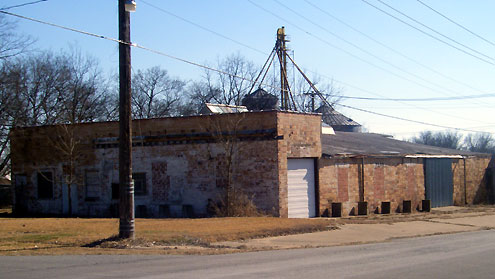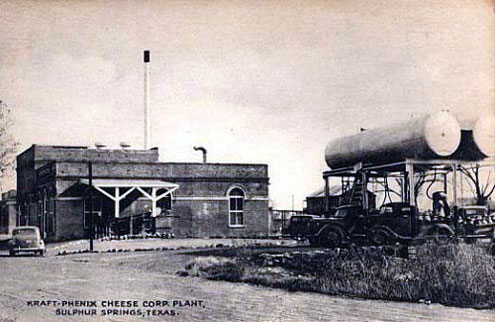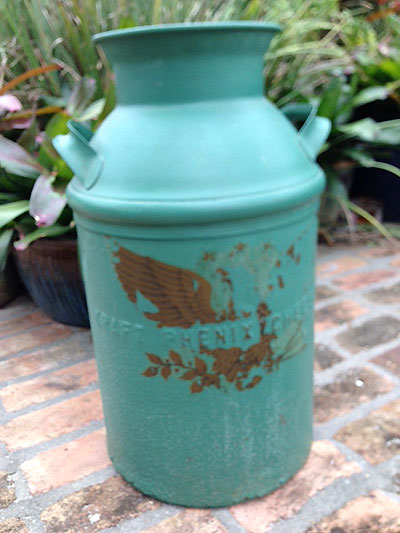Such operations were eventually referred to as Grade B dairies, since they lacked the fancy refinements (i.e., concrete floors, stainless steel equipment, etc.) associated with Grade A facilities. Many such dairies dotted the landscape of North Texas and southern Oklahoma. It was a time when local farmers supplied the dairy needs of local consumers. It was a logical system, unlike today when the vast majority of dairy products sold in Fannin County are trucked in from a hundred to two hundred miles away.
By the early 1930s the production capabilities of Grade B dairies caught the attention of a corporate giant bent on putting as much cheese production under its roof as possible, the Kraft-Phenix Corporation (later known as Kraft Foods).
The Encyclopedia of Chicago states:
James L. Kraft, born in Ontario, Canada, started a cheese-delivery business in Chicago in 1903. Within a few years, Kraft was producing cheese as well as distributing it, and the company grew. . . . In 1928, a merger with Phenix Cheese created Kraft-Phenix, a large food company that supplied 40 percent of all the cheese consumed in the United States.
In 1934 Kraft-Phenix announced plans to put a plant here. A front page story in the April 12, 1934 Bonham Daily Favorite reported that Mr. J. B. Riddle, general manager of the Kraft-Phenix plant in Denison (acquired by Kraft in the late 1920s), recommended putting a cheese making plant in Bonham. “After inspecting a number of buildings,” the article noted, “Mr. Riddle stated that the old potato curing building was the best suited for the factory.” The article further noted that it would be “necessary . . . to put in a concrete floor and make other improvements needed for a cheese factory.”
The April 26 Daily Favorite reported that a deal for Kraft-Phenix to use the potato building, located in the southeast corner of the intersection of Chestnut and East Second streets, had been reached. It was hoped that a cheese factory would be operating by early summer.

The early summer prediction was a bit ambitious. It was late fall before the Daily Favorite finally reported on November 27 that the new factory would open on December 10. Despite the delay, the economic good news was still welcomed. It was, after all, the midst of the Great Depression. The article further noted that 5,000 pounds of milk (roughly 625 gallons) was hoped for on opening day.
In the meantime, the roads between Denison and Bonham stayed busy. The December 5 Daily Favorite carried one story about Fannin County milk farmers and other citizens planning to visit the Denison plant. Below it was another article about Kraft officials from Chicago meeting with company leaders in Denison to make a trip to Bonham. It seems there was plenty of excitement to go around.
On opening day, the Daily Favorite reported: “Over 3,000 pounds of sweet milk were delivered by 56 dairy farmers to the cheese factory today,” somewhat short of the 5,000 pounds first hoped for.
(Bonham was not alone in the opening of such a plant. From the mid 1930s to the early ‘40s Kraft-Phenix opened similar facilities in Victoria, Cameron, Winnsboro, Grapeland, Sulphur Springs and Rusk.)

Apparently the company had drivers who used their personal trucks to pick up raw milk. “The eight or nine route men,” the December 10 Daily Favorite further noted, “kept coming in until about noon.”
Interest in selling to the Kraft plant even caused some dairy farmers to think in terms of a new feed strategy. The February 28, 1935 Daily Favorite featured a front page story about Lannius farmers preparing to build trench silos. The article noted that with trench silos “green feed can be available every day during the winter months.” Green feed, it further noted, “is absolutely essential to keep milk coming during the months when grass has been killed by cold weather.”
By the early spring of 1935 business had picked up at the cheese plant. The April 1 Bonham Daily Favorite reported that the plant was taking in over 11,000 pounds of milk daily. And the total might have been higher if not for the fact that the collapse of the suspension bridge over Red River at Sowell’s Bluff (January 29, 1934) had left dairy farmers in southern Bryan County somewhat stranded. The March 2 Daily Favorite had noted that as much as “3,500 to 5,000 pounds of milk daily” could be brought to the Bonham plant by “dairy farmers in the Yuba school community.”
Throughout the 1940s and 50s the Kraft plant remained a vital part of the local economy. Special business sections of local newspapers reported yearly on its contribution to local farm income. Moreover, the January 13, 1955 Daily Favorite reported: “A series of meetings to promote the dairy industry in the Bonham area have been set by the Kraft Foods Co. . . . .” The meetings were held in Nunnelee, Edhube, Ector, Dodd City, Bailey, Allen’s Chapel, and Ivanhoe.
(In addition to Kraft, in 1947 a local family named Robbins opened a dairy processing facility on East Fourth Street, now East Sam Rayburn Drive, that bought from local dairies. They sold pasteurized milk, cream, butter and ice cream. It was known as Robbins Milk & Ice Cream Co.)
Many county residents recall the various activities related to the Kraft plant. Those who delivered their milk personally remember seeing the steel cans of milk, five and ten gallon sizes, being loaded onto rollers, later replaced by a conveyor belt, and making their way to the vats where the cheese making began. The whole process was aided by fifteen to thirty employees donned in white clothes and coats. Still others recall picking up excess whey (the watery residue from the cheese making process) and hauling it home to feed to hogs.
In early 1962 cheese production was still going strong at the Kraft Foods plant. The April 4, 1962 Daily Favorite referred to the plant as an “industry bright spot” and carried an article entitled “Kraft Foods Keeps Dairy Income High.”
The article noted: “During 1961, the plant received between 18,000,000 and 20,000,000 pounds of milk from a wide area of North Texas and a slice across Southern Oklahoma.” The Kraft plant manager was quoted as saying: “We have milk trucks covering the area from Paris to Muenster and from Greenville north to Kenefic, Okla. . . .” It also reported that the plant had produced 1,000,000 pounds of cheese the same year which was shipped to the company’s distribution center in Garland.
It appeared that Kraft would be around for quite a while longer.
Despite the rosy outlook, just five weeks later the May 16 Daily Favorite reported that Kraft was selling its operations to its plant manager, Mr. J. D. Butler. Kraft officials announced that they would continue buying from the plant, and that they had every confidence in Butler’s ability to produce high quality cheese. The plant name was changed to Butler Milk and continued as such for roughly five years.
The eventual closing of the plant, and the subsequent downward spiral of Fannin County’s dairy industry, symbolized the further concentration of the dairy processing industry in Texas and the nation. What was once done quite well on a local and diversified basis would be done in large, centralized facilities far, far away.

Anyone with photographs of the Kraft plant during its heyday is free to contact me at (903)227-1772 or tim.davis@bonhamisd.org
Tim Davis teaches at Bonham High School.